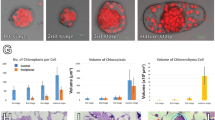Summary
The development of proplastids to chloroplasts or leucoplasts was followed in uniseriate nonglandular hairs, containing chloroplasts, and in glandular hairs, containing leucoplasts, ofStachys lanata leaves. Both hairs grow at the same time from the epidermis.
Both chloroplasts and leucoplasts originate from structurally identical proplastids in meristematic cells. At the early stage, ribosomes are absent. After production of the first ribosomes, each plastid population differentiates along its own developmental pathway.
In nonglandular hairs, ribosome multiplication occurs within the plastid stroma and a thylakoid system with grana stacks is formed. Ribosomes are attached to membrane vesicles produced by the inner membrane of the plastid envelope, to thylakoids, or are clustered in specialized areas of the stroma. Further development produces typical, small differentiated chloroplasts.
In glandular hairs, the production of additional complete ribosomes ceases early. Smaller, transient dense particles are seen within the stroma in the course of the developmental process. The plastids increase in size and there is a transient tubular system but no thylakoids develop. Plastid division proceeds by neck constriction. The latter stage of leucoplast differentiation is characterized by the complete disappearance of ribosomal material and of tubular inner membranes. DNA nucleoids are obvious throughout the developmental period.
Unlike chloroplasts, the development of these nonphotosynthetic heterotrophic organelles and the expression of their specialized metabolic activity probably does not involve the synthesis of specific peptides via plastoribosomes.
Similar content being viewed by others
Abbreviations
- ER:
-
endoplasmic reticulum
- pe:
-
plastid envelope
- pmt:
-
plastid microtubule
- ptRNA:
-
plastid RNA
- r:
-
proteins ribosomal proteins
- rRNA:
-
ribosomal RNA
- st:
-
starch
- DNA :
-
DNA nucleoids
- pe :
-
plastid envelope
- pmt :
-
“plastid microtubules”
- st :
-
starch. For all figures, magnification bar=0.3 μm
References
Bendayan M (1981) Ultrastructural localization of nucleic acids by the use of enzyme-gold complexes. J Histochem Cytochem 29: 531–541
Bradbeer JW (1977) Chloroplasts—structure and development. In:Smith H (ed) The molecular biology of plant cells. Blackwell Scientific Publishers, Oxford, p 64
Carde JP (1984) Leucoplasts: a distinct kind of organelles lacking typical 70 S ribosomes and free thylakoids. Eur J Cell Biol 34: 18–26
— (1987) Electron microscopy of plant cell membranes. In:Douce R, Packer L (eds) Plant cell membranes. Methods in enzymology 148: 599–622. Academic Press, Orlando
—,Joyard J, Douce R (1982) Electron microscopic studies of envelope membranes from spinach plastids. Biol Cell 44: 315–324
Charon J, Launay J, Carde JP (1987) Spatial organization and volume density of leucoplasts in pine secretory cells. Protoplasma 138: 45–53
Cheniclet C, Carde JP (1985) Presence of leucoplasts in secretory cells and of monoterpenes in the essential oil: a correlative study. Isr JBot 34: 219–238
— — (1987) Ultrastructural localization of RNAs in plastids with an RNAse-gold method. Biol Cell 59: 79–88
Feierabend J, Schrader-Reichardt V (1976) Biochemical differentiation of plastids and other organelles in rye leaves with a high-temperature induced deficiency of plastid ribosomes. Planta 129: 133–145
—,Mikus M (1977) Occurrence of a high-temperature sensitivity of chloroplast ribosome formation in several higher plants. Plant Physiol 59: 863–867
Gleizes M, Pauly G, Carde JP, Marpeau A, Bernard-Dagan C (1983) Monoterpene hydrocarbon biosynthesis by isolated leucoplasts ofCitrofortunella mitis. Planta 159: 373–381
Lawrence ME, Possingham JV (1984) Observations of microtu-bule-like structures within spinach plastids. Biol Cell 52: 77–82
Metcalfe CR, Chalk L (1957) Anatomy of the Dicotyledons, vol 2. Clarendon Press, Oxford, pp 1041–1053
Reiss T, Bergfeld R, Link G, Thien W, Mohr H (1983) Photooxidative destruction of chloroplasts and its consequence for cytosolic enzyme levels and plant development. Planta 159: 518–528
Scott NS, Possingham JV (1982) Leaf development. In:Smith H, Grierson D (eds) The molecular biology of plant development. Blackwell, Oxford, pp 223–255
Swanson EB, Tomes DT, Hopkins WG (1983) Modifications to callus culture characteristics and plastid differentiation by the formation of an albino callus ofLotus corniculatus. Can J Bot 61: 2500–2505
Walbot V, Coe EH (1979) Nuclear gene iojap conditions: a programmed change to ribosome-less plastids inZea mays. Proc Natl Acad Sci USA 76: 2760–2764
Whatley JM (1977) Variations in the basic pathway of chloroplast development. New Phytol 78: 407–420
— (1979) Plastid development in the primary leaf ofPhaseolus vulgaris: variations between different types of cell. New Phytol 82: 1–10
Author information
Authors and Affiliations
Rights and permissions
About this article
Cite this article
Cheniclet, C., Carde, J.P. Differentiation of leucoplasts: Comparative transition of proplastids to chloroplasts or leucoplasts in trichomes ofStachys lanata leaves. Protoplasma 143, 74–83 (1988). https://doi.org/10.1007/BF01282961
Received:
Accepted:
Issue Date:
DOI: https://doi.org/10.1007/BF01282961



